Lynette Silver | |
|---|---|
| Born | 1945 (age 78–79) |
| Occupation(s) | Military historian, author |
Lynette Ramsay Silver, AM , MBE (born 1945) is an Australian historian and author. She has written a number of books dealing with Australian and military history.
Lynette Silver | |
|---|---|
| Born | 1945 (age 78–79) |
| Occupation(s) | Military historian, author |
Lynette Ramsay Silver, AM , MBE (born 1945) is an Australian historian and author. She has written a number of books dealing with Australian and military history.
Silver's first book, published in 1986, A Fool's Gold?, deals with the first discoveries of payable gold in Australia and was written after she discovered archival documents "lost" for 134 years. Her next book, The Battle of Vinegar Hill, first published in 1989, is the first (and only) full account of the Irish insurrection Castle Hill convict rebellion of 1804. Sandakan – A Conspiracy of Silence, published in 1998, uncovered the fate of 2428 Australian and British prisoners of war who died at the Sandakan POW Camp in Borneo or on one of the death marches, and investigated the coverup of a failed rescue mission Operation Kingfisher (World War II). 2004's The Bridge at Parit Sulong is an investigation into the massacre of allied prisoners by Japanese soldiers in Malaya in 1942. Further books, mainly related to military history, followed.
Silver was awarded an honorary Medal of the Order of Australia (OAM) in 2004 for "service to veterans and their families, particularly as an organiser of battlefield tours and commemorative services". [1] She was advanced to Member of the Order of Australia (AM) in the 2019 Australia Day Honours for "significant service to the community through historical battlefield tours and commemorative services", [2] and appointed a Member of the Order of the British Empire (MBE) in the 2024 New Year Honours for services to British families of Second World War personnel. [3]
Silver is married and has two children and three grandchildren.
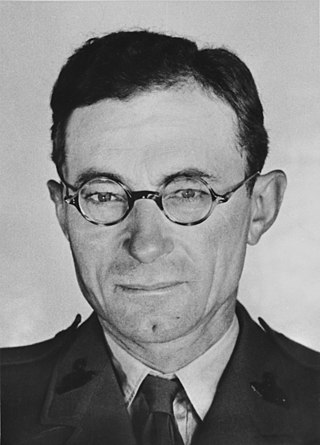
Lieutenant Colonel Charles Groves Wright Anderson was a South African-born Australian soldier, farmer, and politician. He was a recipient of the Victoria Cross and a member of the Australian House of Representatives.

The Sandakan Death Marches were a series of forced marches in Borneo from Sandakan to Ranau which resulted in the deaths of 2,434 Allied prisoners of war held captive by the Empire of Japan during the Pacific campaign of World War II at the Sandakan POW Camp, North Borneo. By the end of the war, of all the prisoners who had been incarcerated at Sandakan and Ranau, only six Australians survived, all of whom had escaped. It is widely considered to be the single worst atrocity suffered by Australian servicemen during the Second World War.
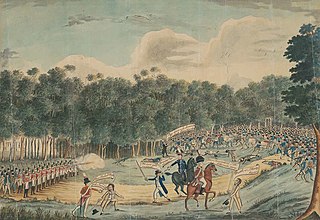
The Castle Hill convict rebellion was an 1804 convict rebellion in the Castle Hill area of Sydney, against the colonial authorities of the British colony of New South Wales. Led by veterans of the United Irish Rebellion of 1798, the poorly armed insurgents confronted the colonial forces of Australia on 5 March 1804 at Rouse Hill. Their rout in the resulting skirmish was hailed by loyalists as Australia's Vinegar Hill after the 1798 Irish Battle of Vinegar Hill, where rebels in Ireland were decisively defeated. The incident was the first major convict uprising in Australian history to be suppressed under martial law.

Kundasang is a hill station in the district of Ranau in Sabah, Malaysia that lies along the bank of Kundasang Valley within the Crocker Range, and also neighboring the town of Pekan Nabalu. It is located about 6 kilometres away from Kinabalu National Park, 15.6 kilometres from Ranau town and is renowned for its vegetable market which is open seven days a week. It is the closest town to Mount Kinabalu and has a panoramic view of the mountain. It is populated mainly by the native Dusun and a small population of Chinese people. Almost all the shops are operated by locals.

Lisa Gaye Curry, also known by her married name Lisa Curry-Kenny, is an Australian former competition swimmer.

The Parit Sulong Massacre was a Japanese war crime committed by members of the Imperial Japanese Army on 22 January 1942 in the village of Parit Sulong, British Malaya. Soldiers of the Imperial Guards Division summarily executed approximately 150 wounded Australian and Indian prisoners of war who had surrendered.
Jack Wong Sue,, also known as Jack Sue, was a Chinese Australian from Perth, Western Australia. Wong Sue served as a member of the commando/special reconnaissance section, Z Special Unit, during the Second World War and was decorated with the Distinguished Conduct Medal. After the war, Wong Sue was a businessman, owning a diving store in the Perth suburb of Midland. He was also an author, a guide for tours of Borneo and a musician, who performed with bands in Perth for about 60 years.
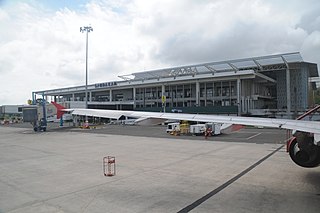
Sandakan Airport is a domestic airport which serves Sandakan in Sandakan District, Sabah, Malaysia. It is located 14 km (8.7 mi) west of downtown Sandakan. In 2005, the airport handled 621,513 passengers and registered 10,876 flights.
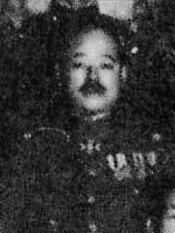
Takuma Nishimura was a Japanese army general in the Imperial Japanese Army during World War II, active in the invasion and occupation of British Malaya. After the Japanese surrender, he was tried and convicted in British Singapore as a war criminal for his role in the Sook Ching massacres. After four years imprisonment he was handed to Australian authorities for trial on the Parit Sulong Massacre and executed by hanging by the then Australian Territory of Papua and New Guinea.

Batu Lintang camp at Kuching, Sarawak on the island of Borneo was a Japanese-run internment camp during the Second World War. It was unusual in that it housed both Allied prisoners of war (POWs) and civilian internees. The camp, which operated from March 1942 until the liberation of the camp in September 1945, was housed in buildings that were originally British Indian Army barracks. The original area was extended by the Japanese, until it covered about 50 acres. The camp population fluctuated, due to movement of prisoners between camps in Borneo, and as a result of the deaths of the prisoners. It had a maximum population of some 3,000 prisoners.

The Battle of Muar was the last major battle of the Malayan Campaign during the Second World War. It took place from 14–22 January 1942 around Gemensah Bridge and on the Muar River. After the British defeat at Slim River, General Archibald Wavell, commander of ABDA, decided that Lieutenant General Lewis Heath's III Indian Corps should withdraw 240 kilometres (150 mi) south into the State of Johore to rest and regroup, while the 8th Australian Division would attempt to stop the Japanese advance.
James Gowing Godwin was a pilot of the Royal New Zealand Air Force during the Second World War, who subsequently became a prisoner of war. After the end of the war, as a captain in the Australian Army, he became an investigator with the Second Australian War Crimes Section in Tokyo in July 1947 and developed the case against Lieutenant General Takuma Nishimura, the senior perpetrator of the Parit Sulong Massacre. He subsequently worked for the First Australian War Crimes Section, based in Singapore, then worked for the British colonial service. He died in Sydney at the age of 72.

Ernest Albert Toovey MBE, OAM was an Australian cricketer and baseball player. In cricket, Toovey was a left-handed batsman who bowled slow left-arm orthodox. He was born at Warwick, Queensland.
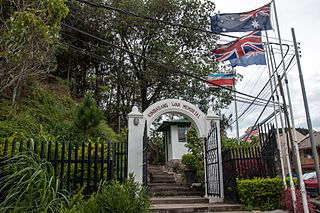
The Kundasang War Memorial is a memorial located in Kundasang in the Malaysian state of Sabah, which is dedicated to the British and Australian soldiers who died in the Sandakan POW camp during their death marches to Ranau. Besides that, it also recognises the suffering and sacrifice of the native population of Sabah.

Quailey's Hill Memorial is a memorial in Ranau District, Sabah, Malaysia. It commemorates an Australian POWs, Allan Quailey who been killed on 16 February 1945 during the first Sandakan Death Marches by the Japanese soldiers.

The Sandakan Memorial Park is a memorial site built in the former grounds of the former Sandakan camp in the Malaysian state of Sabah. The site is dedicated as a memory for all prisoners in the camp who died during the Sandakan Death Marches, and to those died during a march to Ranau. It is also recognises the suffering and sacrifice of the native population. This park hosts the Sandakan Memorial Day service on August 15.
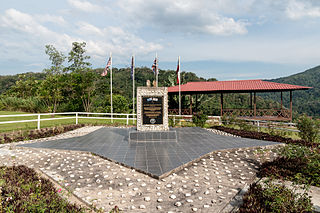
The Last POW Camp Memorial is a memorial in the district of Ranau in the Malaysian state of Sabah, which commemorates the victims of the Sandakan Death Marches who died during their march to Ranau. Of 1,047 British and Australian POWs, only 189 reach this site which is located near Liwagu Valley. Of these 189 total, 153 prisoners died in the next six weeks, 32 were murdered, while only four managed to escape. The current memorial was built where the former camp was located.

Lieutenant Colonel Reginald William James Newton, was an Australian Army officer noted for his leadership while in Japanese prisoner of war camps during the Second World War. He became well known among Australian military circles, where he was affectionately known as "Roaring Reggie."

Naval Base Borneo and Naval Base Dutch East Indies was a number of United States Navy Advance Bases and bases of the Australian Armed Forces in Borneo and Dutch East Indies during World War II. At the start of the war, the island was divided in two: British Borneo and Dutch East Indies. Both fell to the Empire of Japan, Japan occupied British Borneo and the Dutch East Indies in 1942 until 1945.